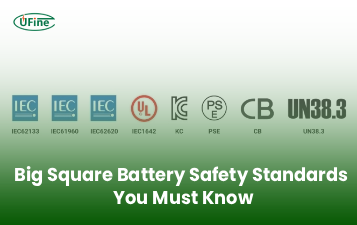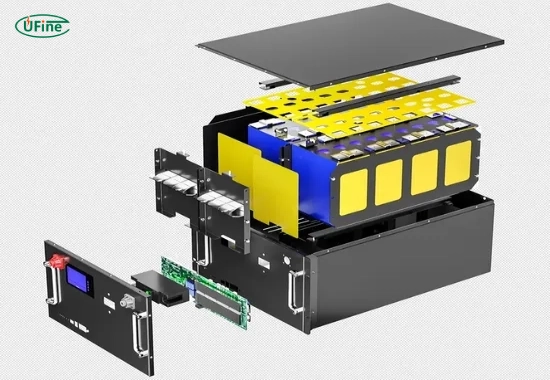
- Part 1. What is a lithium storage battery?
- Part 2. What are the main types of lithium storage batteries?
- Part 3. What are the key specifications of lithium storage batteries?
- Part 4. How long does a lithium storage battery last?
- Part 5. What are the main uses of lithium storage batteries?
- Part 6. Are lithium storage batteries safe?
- Part 7. How to charge a lithium storage battery?
- Part 8. What is the difference between lithium and lead-acid batteries?
- Part 9. How to choose the best lithium storage battery?
- Part 10. What are the pros and cons of lithium storage batteries?
- Part 11. FAQs about lithium storage battery
Looking for the best energy storage technology for your home, RV, or solar system? A lithium storage battery might be the perfect solution. These batteries are known for their long lifespan, lightweight design, and high energy density, making them an ideal choice for many modern applications.
So, what exactly is a lithium storage battery? A lithium storage battery is a rechargeable battery that stores and releases energy by moving lithium ions between electrodes. It is widely used in solar energy systems, electric vehicles, portable electronics, and backup power solutions.
This in-depth guide will help you understand everything about lithium storage batteries. We will cover how they work, their types, specifications, benefits, and real-world use cases.
Part 1. What is a lithium storage battery?
A lithium storage battery is a rechargeable battery that uses lithium ions as the main component of its electrochemistry. These batteries are known for delivering high energy in a compact and lightweight form.
How does a lithium battery work?
When a lithium battery charges, lithium ions move from the positive electrode (cathode) to the negative electrode (anode) through an electrolyte. When the battery discharges, the ions return to the cathode, releasing stored energy as electricity.
This ion movement is extremely efficient, allowing lithium batteries to store more energy in a smaller space than traditional batteries.
Part 2. What are the main types of lithium storage batteries?
Not all lithium batteries are the same. Different chemistries offer different benefits. Here are the most common types:
1. Lithium Iron Phosphate (LiFePO4)
This is one of the safest and most stable lithium chemistries. It has a long cycle life and consistent power output.
- Cycle life: 2000 to 5000 cycles
- Voltage per cell: 3.2V
- Applications: Solar storage, RVs, marine, backup systems
2. Lithium Cobalt Oxide (LiCoO2)
High energy density makes this type ideal for small electronics, but it is less stable under high loads.
- Cycle life: 500 to 1000 cycles
- Voltage per cell: 3.7V
- Applications: Smartphones, laptops, tablets
3. Lithium Manganese Oxide (LiMn2O4)
Offers good thermal stability and moderate energy density.
- Cycle life: 300 to 700 cycles
- Voltage per cell: 3.7V
- Applications: Power tools, medical devices
4. Lithium Nickel Manganese Cobalt Oxide (NMC)
Balanced performance makes it popular for electric vehicles and power storage.
- Cycle life: 1000 to 2000 cycles
- Voltage per cell: 3.6 to 3.7V
- Applications: Electric cars, e-bikes, portable energy systems
5. Lithium Titanate (LTO)
Known for ultra-fast charging and extreme durability.
- Cycle life: 10,000 to 20,000 cycles
- Voltage per cell: 2.4V
- Applications: Military, industrial, grid storage
Part 3. What are the key specifications of lithium storage batteries?
When choosing a lithium battery, understanding its specifications helps you match it to your needs.
Voltage
Most lithium cells produce between 3.2 to 3.7 volts. Batteries are grouped into packs to achieve higher voltages such as 12V, 24V, or 48V depending on the system requirements.
Capacity
Capacity is measured in amp-hours (Ah) or milliamp-hours (mAh). It tells you how much energy the battery can store. For example, a 100Ah battery can deliver 100 amps for one hour or 10 amps for 10 hours.
Energy
Energy is measured in watt-hours (Wh) and calculated by multiplying voltage by capacity. For instance, a 12V 100Ah battery has 1200Wh of energy.
Discharge Rate (C-rate)
The C-rate indicates how quickly a battery can be charged or discharged. A 1C battery can be discharged in one hour. A 0.5C battery takes two hours.
Cycle Life
Cycle life is the number of full charge and discharge cycles a battery can complete before its capacity drops below 80 percent of the original.
Depth of Discharge (DoD)
This is how much of the battery’s capacity can be safely used. Lithium batteries can usually be discharged 80 to 100 percent without damage, unlike lead-acid batteries which have a safe DoD of only 50 percent.
Part 4. How long does a lithium storage battery last?
Lithium storage batteries are designed to last many years. Their lifespan depends on usage, temperature, and charging habits.
Average lifespans by type:
- LiFePO4: 10 to 15 years
- NMC: 7 to 10 years
- LTO: 15 to 25 years
- LiCoO2: 3 to 5 years
Proper maintenance and using a good battery management system (BMS) can increase battery life significantly.
Part 5. What are the main uses of lithium storage batteries?
- Solar Energy Storage
- Used in homes and businesses to store solar energy during the night or power outages.
- Electric Vehicles (EVs)
- Powering the heart of electric cars like Tesla, Nissan Leaf, and many others.
- Recreational Vehicles (RVs) and Marine
- Provide lightweight, long-lasting off-grid power.
- Home Backup Systems
- Serve as emergency power during grid failures.
- Consumer Electronics
- Powering devices like smartphones, laptops, drones, and cameras.
- Industrial Applications
- Used in forklifts, robotics, and remote monitoring systems.
Part 6. Are lithium storage batteries safe?
Yes, lithium batteries are generally safe when manufactured and used correctly. Most lithium batteries include a Battery Management System (BMS) that monitors and protects the battery from:
- Overcharging
- Deep discharge
- Short circuits
- Overheating
LiFePO4 batteries are considered the safest type due to their chemical stability and resistance to thermal runaway.
Part 7. How to charge a lithium storage battery?
Charging a lithium battery requires a compatible charger. Using a charger not designed for lithium can damage the battery or reduce its lifespan.
Charging tips:
- Use a lithium-compatible smart charger
- Avoid charging in very cold or hot temperatures
- Do not exceed the recommended voltage
- Monitor the charge level through the BMS or display screen
For solar systems, use a solar charge controller that supports lithium profiles.
Part 8. What is the difference between lithium and lead-acid batteries?
Here’s a detailed comparison with real-world data:
| Feature | Lithium Battery (LiFePO4) | Lead-Acid Battery (AGM/Deep Cycle) |
|---|---|---|
| Energy Efficiency | 95% to 98% | 70% to 80% |
| Weight (100Ah 12V) | 11 to 14 kg | 28 to 32 kg |
| Usable Capacity | 80% to 100% | 50% to 60% |
| Cycle Life | 3000 to 5000 cycles | 300 to 800 cycles |
| Charging Time | 2 to 4 hours | 6 to 12 hours |
| Maintenance | None | Regular water checks and equalizing |
| Self-Discharge Rate | 1% per month | 5% to 15% per month |
| Cost (100Ah 12V) | $500 to $900 | $150 to $300 |
| Operating Temperature | -20°C to 60°C | 0°C to 45°C |
While lithium batteries are more expensive upfront, they offer greater long-term value, especially in deep-cycle and off-grid applications.
Part 9. How to choose the best lithium storage battery?
To find the right lithium battery for your needs, consider the following:
- Power requirements: How many watt-hours do you need daily?
- Voltage compatibility: Match the battery voltage with your inverter or system
- Application: Is it for solar, RV, marine, or backup?
- Space and weight: Lithium saves space and reduces weight
- Budget: Higher-quality batteries offer better performance and longer life
Also, look for certifications, warranties, and customer reviews before buying.
Part 10. What are the pros and cons of lithium storage batteries?
Pros:
- High energy efficiency
- Long cycle life
- Lightweight and compact
- Fast charging
- Maintenance-free
- Consistent voltage output
Cons:
- Higher upfront cost
- Sensitive to extreme cold
- Requires protection circuits (BMS)
- Cannot be charged below freezing without heating
Despite the cons, the overall benefits make lithium the best choice for modern energy storage.
Part 11. FAQs about lithium storage battery
Can I use a lithium battery with my existing solar system?
Yes, most modern solar charge controllers support lithium batteries. Just make sure your controller has a lithium charging profile.
Can I replace lead-acid batteries with lithium?
Yes, but ensure your system can handle lithium’s charging parameters. You may need to upgrade your charger or add a Battery Management System.
Is it safe to leave a lithium battery connected all the time?
Yes, as long as it has a BMS and a proper charger. These systems prevent overcharging and damage.
What size lithium battery do I need for backup power?
It depends on how much energy your devices use. For example, a 100Ah 12V battery provides 1200Wh, enough to power a 100W device for 12 hours.
Can I store lithium batteries during winter?
Yes, but store them at room temperature in a dry place. If stored in freezing conditions, the battery should not be charged until it warms up.
Related Tags:
More Articles

Big Square Battery Safety Standards You Must Know
Learn key safety standards for big square batteries to avoid fire risks, shipping delays, and compliance issues in EV, industrial, and energy storage projects.
Big Square Battery Applications in Solar & Industrial Equipment
Big square batteries deliver high capacity, stable output, and long life for solar, industrial, and backup power. Explore key uses and advantages.
Big Square Battery vs Cylindrical Battery: Complete 2025 Guide for EVs, ESS & Industrial Devices
Choosing the right battery is key for designers and engineers. Compare big square vs cylindrical batteries to find the best fit for your application.
How to Choose the Right Big Square Battery for Your Device?
If you’re choosing a big square battery for EVs, solar, or mobility devices, this guide helps you pick the right solution for real-world needs.
Big Square Battery Complete Guide: Types, Uses & Buying Tips
If you are choosing a big square lithium battery for EVs, solar, RVs, or AGVs, this guide helps you select the right NMC, LFP, or LTO solution with examples.




